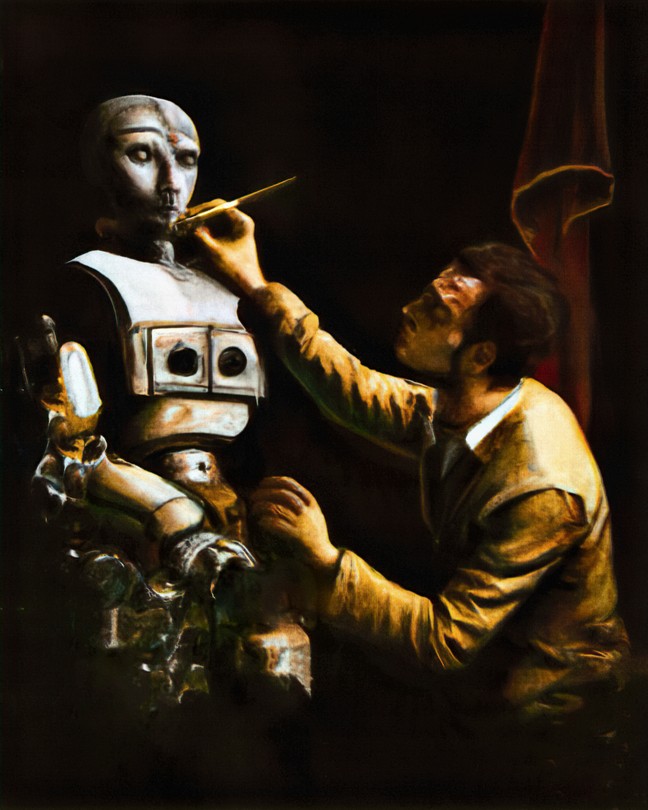Technology Makes Us More Human – The Atlantic
When techno-optimists use ChatGPT, they see Star Trek: a future in which opportunities for personal fulfillment are as large as the universe itself.

ChatGPT, a new AI system that sounds so human in conversations that it could host its own podcast, is a test of temperament. Reading between its instantly generated, flawlessly grammatical lines, people see wildly different visions of the future.
For some, ChatGPT promises to revolutionize the way we search for information, draft articles, write software code, and create business plans. When they use ChatGPT, they see Star Trek: a future in which opportunities for personal fulfillment are as large as the universe itself.
Others see only massive job displacement and a profound loss of agency, as we hand off creative processes that were once the domain of humans to machines. When they use ChatGPT, they see Black Mirror: a future in which technological innovation primarily exists to annoy, humiliate, terrify, and, most of all, dehumanize humanity.
I’m firmly in the Star Trek camp, because although I fully acknowledge that the tech industry is imperfect, and always in need of thoughtful, responsive leadership, I still believe that improvement through technology is how humanity most effectively makes progress.
That’s why I switched from a planned career in academia to one in Silicon Valley in the first place. In the early 1990s, I saw how software, globally distributed on the internet, was creating new opportunities to empower people at scale, and that’s ultimately what led me to co-found LinkedIn. I wanted to use technology to help individuals improve their economic opportunities over the course of their entire career, and thus have more chances to pursue meaning in their lives.
Techno-humanism is typically conflated with transhumanism, referring to the idea that we are on a path to incorporating so much technology into our lives that eventually we will evolve into an entirely new species of post-humans or superhumans.
I interpret techno-humanism in a slightly different way. What defines humanity is not just our unusual level of intelligence, but also how we capitalize on that intelligence by developing technologies that amplify and complement our mental, physical, and social capacities. If we merely lived up to our scientific classification—Homo sapiens—and just sat around thinking all day, we’d be much different creatures than we actually are. A more accurate name for us is Homo techne: humans as toolmakers and tool users. The story of humanity is the story of technology.
Technology is the thing that makes us us. Through the tools we create, we become neither less human nor superhuman, nor post-human. We become more human.
This doesn’t mean that all technological innovations automatically produce good outcomes—far from it. New technologies can create new problems or exacerbate old ones, such as when AI systems end up reproducing biases (against racial minorities, for instance) that exist in their training data. We in the tech industry should be vigilant in our efforts to mitigate and correct such problems.
Nor would I ever suggest that technologies are neutral, equally capable of being used for good or bad. The values, assumptions, and aspirations we build into the technologies we create shape how they can be used, and thus what kinds of outcomes they can produce. That’s why techno-humanism should strive for outcomes that broadly benefit humanity.
At the same time, a techno-humanist perspective also orients to the future, dynamism, and change. This means it inevitably clashes with desires for security, predictability, and the familiar. In moments of accelerating innovation—like the one we’re living through right now, as robotics, virtual reality, synthetic biology, and especially AI all evolve quickly—the urge to entrench the status quo against the uncertain terrain of new realities accelerates too.
Just so, New York City’s public-school system has already blocked students and teachers from accessing ChatGPT in its classrooms. Multiple online art communities have banned users from uploading images they created using AI image-generators such as DALL-E, Midjourney, and Stable Diffusion.
I get it. Learning to write an essay from scratch is a time-honored way to develop critical thinking, organizational skills, and a facility for personal expression. Creating vivid and beautiful imagery one painstaking brushstroke at a time is perhaps the epitome of human creativity.
But what if teachers used ChatGPT to instantly personalize lesson plans for each student in their class—wouldn’t that be humanizing in a way that the industrialized approaches of traditional classroom teaching are not? Aren’t tools that allow millions of people to visually express their ideas and communicate with one another in new ways a step forward for humanity?
If it’s detrimental to society to simply claim that “technology is neutral” and avoid any responsibility for negative outcomes—and I believe it is—so is rejecting a technology just because it has a capacity to produce negative outcomes along with positive ones.
Is there a future where the massive proliferation of robots ushers in a new era of human flourishing, not human marginalization? Where AI-driven research helps us safely harness the power of nuclear fusion in time to help avert the worst consequences of climate change? It’s only natural to peer into the dark unknown and ask what could possibly go wrong. It’s equally necessary—and more essentially human—to do so and envision what could possibly go right.





